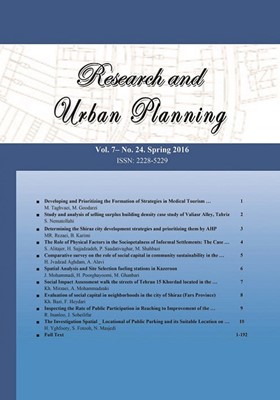تحلیلی بر بازآفرینی بافت محله تاریخی سنگ سیاه شهر شیراز با استفاده از تحلیل ترکیبی ALM-Gis
الموضوعات :
مهدی ابراهیمی
1
,
علیرضا دهداری فرد
2
,
رضا مختاری
3

1 - استاد یار جغرافیا و برنامه ریزی شهری دانشگاه پیام نور، ایران
2 - دانشجو کارشناسی ارشد جغرافیا و برنامه ریزی شهری
3 - دانشیار، جغرافیا و برنامهریزی شهری، دانشگاه اصفهان، اصفهان، ایران
تاريخ الإرسال : 10 السبت , ربيع الأول, 1443
تاريخ التأكيد : 06 الإثنين , رجب, 1443
تاريخ الإصدار : 13 الثلاثاء , ذو القعدة, 1445
الکلمات المفتاحية:
محله سنگ سیاه,
شهر شیراز,
بافت تاریخی,
واژگان کلیدی: باز آفرینی,
ALM-Gis,
ملخص المقالة :
بازآفرینی شهری به مفهوم احیاء، تجدید حیات و نوزایی شـهری و بـه عبـارتی دوبـاره زنـده شـدن شـهری اسـت. در بازآفرینی شهری، توسعه شهری به مفهوم رشد کمی عناصر کالبدی شـهر بـرای اسکان جمعیت و ارتقای کیفیت زندگی، در قالب طرحهای توسعه شهری رخ خواهـد داد. هدف مقالهی حاضر انجام تحلیل بر بازآفرینی بافت تاریخی محله سنگ سیاه شهر شیراز است لذا قلمرو پژوهش بافت محله سنگ سیاه شهر شیراز است. این محله دارای بافت تاریخی و جمعیت متراکم است که از وضعیت نامناسب کالبدی برخوردار است. این محله دارای 12 کوی با جمعیتی معادل 13755 نفر و 13663 ساختمان مسکونی با مساحت 2972 هکتار است. این پژوهش به لحاظ هدف کاربردی و از لحاظ ماهیت توصیفی ـ تحلیلی است. متغیرهایهای مورد مطالعه در آن اسکلت ساختمان، جنس مصالح،، تعداد طبقات، دانهبندی، قدمت ساختمان، نفوذپذیری، کیفیت ابنیه و تعداد واحد است. در این مقاله شاخصهای باز آفرینی در 6 دسته و با ابزار پرسشنامه و نمونه گیری از 359 نفر تحلیل شدند. برای وزن دهی به لایهها در دادههای فضایی از روش خودهمبستگی فضایی موجود در نرم افزارGeoda استفاده شد. همچنین برای بررسی توزیع فضایی اولویتبندی باز آفرینی بافت محله سنگ سیاه از روش خودهمبستگی فضایی موران(Anselin local Morans) در نرم افزار ArcGIS استفاده شده است. نتایج نشان داد که در محدوده بافت؛ 9/9994 هکتار یعنی 63/33 در وضعیت مقاومت خیلی پایین قرار دارد. نتایج حاصل از تجزیه و تحلیل آزمون پارامتریک نشان داد که شاخص حکمروایی و شاخص برنامه ریزی با میانگین(41/3=Mean) و (55/2=Mean) به ترتیب بالاترین و پایین ترین شاخص هستند که این وضعیت نشان از وضعیت نامناسب بافت محله سنگ سیاه دارد.
المصادر:
Adjer,W.N., et al. (2005). Social – Ecological Resilience to coastal disasters . Science 309:1036-1039. https://www.science.org/doi/10.1126/science.1112122
Alizadeh, M. (2016). Vulnerability Assessment of Koohdasht Urban Infrastructure with Passive Defense Approach, Master Thesis, Department of Geography and Urban Planning, Shahid Chamran University of Ahvaz. [In Persian].
Ariana, A., Kazemian, Gh., and Mohammadi, M. (2016). Conflict Management Model of Urban Reconstruction Stakeholders in Iran Case Study: Hemmatabad neighborhood of Isfahan, Journal of Urban Studies, No. 35, pp. 132-117. https://urbstudies.uok.ac.ir/article_61332.html?lang=en [In Persian].
Deavis, M. (2005). Using collaboration as a governance strategy: Lessons from six watershed management programs. Administration & Society, 37(3), 281-320.
A. R. (2020). An Analysis of the Reconstruction of Historical Textures with a Resident Empowerment Approach. Master's thesis in the field of geography and urban planning, Payam Noor University, supervisor Dr. Mehdi Ebrahimi Bozani.
Hashemzadeh Ghaleh Jogh, F., Ebizadeh, S., Safar Alizadeh, I. (1399). Identifying and prioritizing the most important factors in promoting urban management programs in the field of worn texture (Case study: Mako city), Journal of Urban Research and Planning, Year https://jupm.marvdasht.iau.ir/article_3637.html [In Persian].
Gunderson, L.H , Holling,C.S.,. (2018). Resilience and adaptive cycles. In: L H Gunderson and C SHolling (editors). Panarchy: Understanding Transformations in Human and Natural Systems. https://faculty.washington.edu/stevehar/Panarchy.pdf
Kiosheng, G. (2013). Designing institutions for governance in complex environments: Normative rational choice and cultural institutional theories explored and contrasted. Economic and Social Research Council Fellowship Paper 1.
Karimi Yazdi, A., Barati, N., Zarei, M. (2019). Investigating the norms of quality of place perception in the experience of recreating urban space (Case study of Imamzadeh Saleh Tajrish urban complex in Tehran). Journal of Urban Studies, 8 (32), 89-104. https://urbstudies.uok.ac.ir/article_61217.html?lang=en [In Persian].
Karrholm‚ M.‚ Nylund‚ K.‚ Fuente‚ P. (2014),Spatial resilience and urban planning: Addressing the interdependence of urban retail areas‚ Cities‚ Volume36‚ 121–130. https://www.academia.edu/82491147/Spatial_resilience_and_urban_planning_Addressing_the_interdependence_of_urban_retail_areas?f_ri=262
kasino, W. rajer, a, wiliams ,h. (2011). Conflict and negotiation processes in organizations. In M. a. H. Dunnette, L. (Ed.), Handbook of Industrial and Organizational Psychology (pp. 651–717). Palo Alto, CA: Davies- Black® Publishing.
Khoshgadam, F., Razaghi Asl, S. (2016). Presenting Strategies for Improving Environmental Quality in Renovating the Worn Texture of Farahzad Neighborhood Using Strategic-Hierarchical Analysis Method, Journal of Urban Research and Planning, Year 7, No. 27, 58-37. https://jupm.marvdasht.iau.ir/article_2138.html?lang=en [In Persian]
Kiani, A., Kazemi A. A. (2015). Analysis of the distribution of public services in Shiraz with spatial autocorrelation models in ArcGIS and Geoda software, Journal of Urban Research and Planning, Year 6, Number 22, Fall 2015, pp. 14-1 . [In Persian].
Looki , Paul. (2018). overcoming flaws in permeability measures: modified route directness,
journal of urbanism: international research on placemaking and urban sustainability,2019,
12(1):1-14.
Mayunga, J. S. ( 2006). Understanding and Applying the Concept of Community Disaster Resilience: A capital-based approach, Department of Landscape Architecture and Urban Planning, Hazard Reduction & Recovery Center, Texas A&M University. https://www.theisrm.org/documents/Mayunga%20(2007)%20Understanding%20and%20Applying%20the%20Concept%20of%20Community%20Disaster%20Resilience%20-%20A%20Capital-Based%20Aproach.pdf
Mitchell, T., Harris, K. (2012). Resilience: a risk management approach, background note, ODI.P2-3. https://www.preventionweb.net/files/globalplatform/entry_bg_paper~7552.pdf
Naderi, K., Movahed, A., Firoozi, M. Ali., Hadidi, M., Isafi, A. (2013). Identification and prioritization of urban worn-out texture intervention using fuzzy hierarchical analysis model (FAHP) (central area of Saqez), Journal of Spatial Planning and Planning, Volume 18, Number 1, pp. 154-179. [In Persian].
Nazarpour, M.T., Manzoori, M. (2014). Evaluating the Impact of Comprehensive and Detailed Plans of Tehran on the Formation of Dilapidated Tissues: A Case Study of the Sirus Neighborhood of Tehran International Structure, Architecture and Urban Development, [In Persian].
Pajouhan, M., Pourmoghadam, Z. (2018). Strategic urban tourism planning with the approach of recreating the culture based on historical contexts (Case study: the old context of Rasht). Journal of Urban Studies, 7 (27), 53-66. https://urbstudies.uok.ac.ir/article_60850.html?lang=en [In Persian].
Piroozi, K., Nazmfar, H. (2008). Urban Dilapidated Tissues, Physical-Spatial Dimensions The First Conference on Dilapidated Urban Tissues, Sustainable Development Perspectives, Values and Challenges, Ahvaz: Shahid Chamran University. [In Persian].
Poorahmad, A. (2017). Sustainable regeneration of studied urban dysfunctional tissues (District 10 of Tehran). Environmental planning. [In Persian].
Peyvastegar, Y., Heidari, a. a., kiai m. (2017). analysis of urban parks from the perspective of criminology using space layout technique (case study: laleh park in tehran),
quarterly journal of urban studies, 6 ( 22), 15-26. [In Persian].
Rakbin, E.P. (2013). Bring society back in: Grassroots ecosystem management, accountability, and sustainable communities. Cambridge, MA: MIT Press.
Scandari, A., Jafari Mansoorian, H., Mashkori, A., Ahmadli, Z., Khanjani, N., Norzaee,S.,Parvizian, A., Ahmadi, H., Amanpour, S., Derakhshan, A.,2020, Production of noise pollution map with spatial modeling of land use map (case study of Yasuj city),Scientific-Research (Azad University),No 34, Pp7-22. .(persian). DOI:29252/ArchHygSci.7.3.157
Seyffoddini, F., Ziari, K., & Azimi, A.. (2014). Anaysis of Geographical Gaps of Housing Quality in the 22 Areas of Tehran. GEOGRAPHY, 11(39), 213-234. SID. https://sid.ir/paper/606434/en
Soltani, A., Tahaei Moghadam, S. P. (1399). Assessing the status of sustainability components in Saghrisazan neighborhood of Rasht using PESTEL analysis), Journal of Urban Research and Planning, Eleventh Year, No. 42, 36-21. https://jupm.marvdasht.iau.ir/article_3974.html?lang=en [In Persian]
Teng Chey,kh. (2012). The CLC framework for livable and sustainable cities,Urban solutions Journal, 1: 54-70. https://www.clc.gov.sg/docs/default-source/urban-solutions/urb-sol-iss-1-pdfs/researchandreports-the-clc-framework-for-liveable-and-sustainable-cities.pdf
Yang,W., Kang,J.,(2005), Acoustic comfort evaluation in urban open public spaces, Journal of Applied Acoustics, 66,211-229. Dio: https://doi.org/10.1016/j.apacoust.2004.07.011
Zhai, B., Ng M. K. (2013). Urban regeneration and social capital in China: A case study of the Drum Tower Muslim District in Xi’an, Cities Volume 35, December 2013, Pages 14-25. https://www.infona.pl/resource/bwmeta1.element.elsevier-e39a3474-946b-38ae-a4b6-3664a5176688
_||_
![]()


